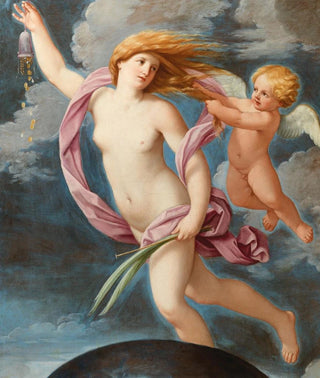Art print | Fortuna with a purse - Guido Reni


View from behind

Frame (optional)
In the fascinating world of baroque art, the art print "Fortuna with a purse" by Guido Reni stands out for its elegance and symbolic depth. This depiction of the goddess of fortune, often seen as a capricious figure, evokes a universe where luck and destiny intertwine. The artist, by capturing the essence of Fortuna, does not merely portray a simple allegory; he invites the viewer to reflect on the ephemeral nature of wealth and happiness. The delicacy of the goddess's features, combined with the richness of colors, creates an atmosphere that is both serene and unsettling, where each gaze becomes an exploration of the human condition in the face of uncertainty.
Style and uniqueness of the work
The appeal of "Fortuna with a purse" lies in Guido Reni's inimitable style, which combines impeccable technique with poetic sensitivity. The flowing drapery surrounding the central figure demonstrates exceptional craftsmanship, while the skillfully orchestrated light gives the entire piece an almost divine dimension. The color palette chosen by Reni, both soft and vibrant, emphasizes the ethereal character of the goddess, while the meticulous details, such as shimmering jewelry and delicate motifs, add visual richness to the work. This blend of realism and idealization makes this piece an emblematic masterpiece of baroque art, where every element contributes to narrating a universal story about fortune and destiny.
The artist and his influence
Guido Reni, a key figure of the 17th century, managed to mark his era with his unique style and his ability to fuse classical influences with baroque aspirations. Born in Bologna, he was trained by the great masters of his time, but his artistic vision quickly asserted itself. Reni captured human emotion with such intensity that his works continue to inspire generations of artists. "Fortuna with a purse" is a perfect example, where mastery of chiaroscuro and the finesse of expressions testify to his genius. His impact does not end

Matte finish

View from behind

Frame (optional)
In the fascinating world of baroque art, the art print "Fortuna with a purse" by Guido Reni stands out for its elegance and symbolic depth. This depiction of the goddess of fortune, often seen as a capricious figure, evokes a universe where luck and destiny intertwine. The artist, by capturing the essence of Fortuna, does not merely portray a simple allegory; he invites the viewer to reflect on the ephemeral nature of wealth and happiness. The delicacy of the goddess's features, combined with the richness of colors, creates an atmosphere that is both serene and unsettling, where each gaze becomes an exploration of the human condition in the face of uncertainty.
Style and uniqueness of the work
The appeal of "Fortuna with a purse" lies in Guido Reni's inimitable style, which combines impeccable technique with poetic sensitivity. The flowing drapery surrounding the central figure demonstrates exceptional craftsmanship, while the skillfully orchestrated light gives the entire piece an almost divine dimension. The color palette chosen by Reni, both soft and vibrant, emphasizes the ethereal character of the goddess, while the meticulous details, such as shimmering jewelry and delicate motifs, add visual richness to the work. This blend of realism and idealization makes this piece an emblematic masterpiece of baroque art, where every element contributes to narrating a universal story about fortune and destiny.
The artist and his influence
Guido Reni, a key figure of the 17th century, managed to mark his era with his unique style and his ability to fuse classical influences with baroque aspirations. Born in Bologna, he was trained by the great masters of his time, but his artistic vision quickly asserted itself. Reni captured human emotion with such intensity that his works continue to inspire generations of artists. "Fortuna with a purse" is a perfect example, where mastery of chiaroscuro and the finesse of expressions testify to his genius. His impact does not end






